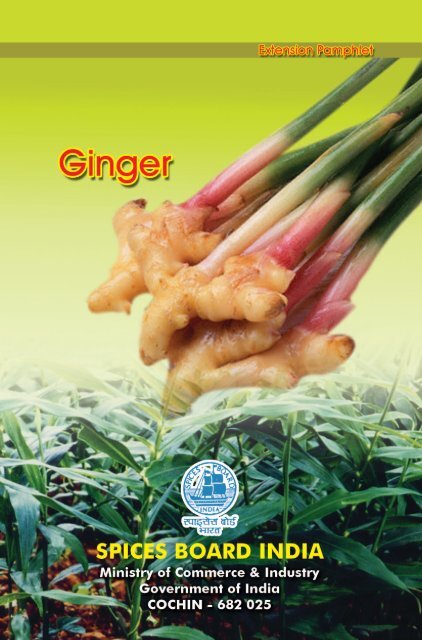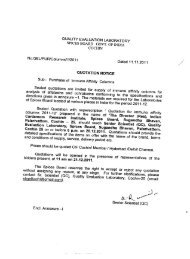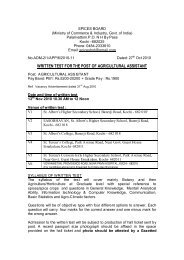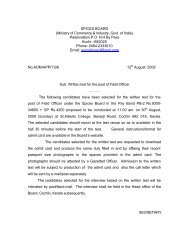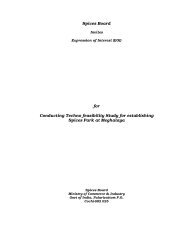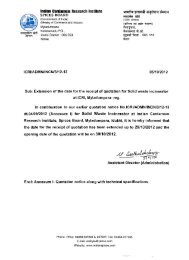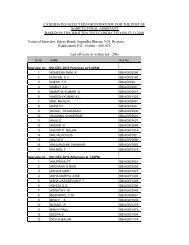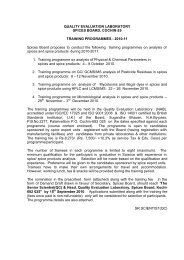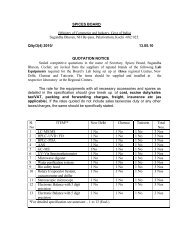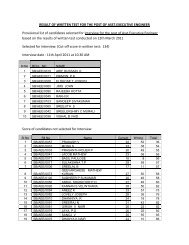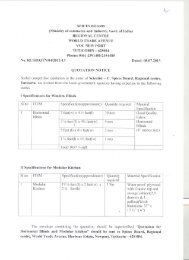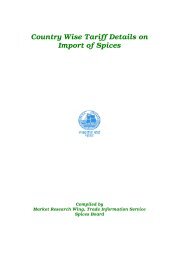You also want an ePaper? Increase the reach of your titles
YUMPU automatically turns print PDFs into web optimized ePapers that Google loves.
<strong>Ginger</strong><br />
(Extension Pamphlet)
GINGER<br />
<strong>Ginger</strong><br />
(Extension Pamphlet)<br />
Contributors<br />
Sasikumar B., Thankamani C.K., Srinivasan V.,<br />
Devasahayam S., Santhosh J. Eapen, Kumar A.<br />
and John Zacharaiah T.<br />
Editors<br />
Srinivasan V., Thankamani C. K., Dinesh R.,<br />
Kandiannan K., Rajeev P.<br />
Publisher<br />
V. A. Parthasarathy<br />
Director<br />
<strong>India</strong>n Institute of <strong>Spices</strong> Research<br />
Calicut<br />
Re-published by<br />
<strong>Spices</strong> <strong>Board</strong><br />
Ministry of Commerce & Industry<br />
Government of <strong>India</strong><br />
Cochin – 682 025<br />
Copies - 6000<br />
February 2009<br />
Printed at<br />
Niseema Printers & Publishers, Kochi - 18<br />
2
GINGER<br />
<strong>Ginger</strong> (Zingiber officinale Rosc) (Family: Zingiberaceae) is a<br />
herbaceous perennial, the rhizomes of which are used as a spice.<br />
<strong>India</strong> is a leading producer of ginger in the world and during 2006-<br />
07 the country produced 3.70 lakh tonnes of the spice from an area<br />
of 1.06 lakh hectares. <strong>Ginger</strong> is cultivated in most of the states in<br />
<strong>India</strong>. However, states namely Kerala, Meghalaya, Arunachal<br />
Pradesh, Mizoram, Sikkim, Nagaland and Orissa together contribute<br />
70 per cent to the countryís total production.<br />
Climate and soil<br />
<strong>Ginger</strong> grows well in warm and humid climate and is cultivated<br />
from sea level to an altitude of 1500 meters above sea level. <strong>Ginger</strong><br />
can be grown both under rain fed and irrigated conditions. For<br />
successful cultivation of the crop, a moderate rainfall at sowing time<br />
till the rhizomes sprout, fairly heavy and well distributed showers<br />
during the growing period and dry weather for about a month before<br />
harvesting are necessary. <strong>Ginger</strong> thrives best in well drained soils<br />
like sandy loam, clay loam, red loam or lateritic loam. A friable loam<br />
rich in humus is ideal. However, being an exhausting crop it is not<br />
desirable to grow ginger in the same soil year after year.<br />
Varieties<br />
Several cultivars of ginger are grown in different ginger growing<br />
areas in <strong>India</strong> and they are generally named after the localities where<br />
they are grown. Some of the prominent indigenous cultivars are<br />
Maran, Kuruppampadi, Ernad, Wynad, Himachal and Nadia. Exotic<br />
cultivars such as Rio-de-Janeiro have also become very popular<br />
among cultivators. The improved varieties of ginger and their salient<br />
features are given in Table 1 and Table 2.<br />
Season<br />
The best time for planting ginger in the West Coast of <strong>India</strong> is<br />
during the first fortnight of May with the receipt of pre-monsoon<br />
showers. Under irrigated conditions, it can be planted well in advance<br />
during the middle of February or early March. Burning the surface<br />
soil and early planting with the receipt of summer showers results in<br />
higher yield and reduces disease incidence.<br />
3
GINGER<br />
Table 1. Improved varieties of ginger<br />
Variety Fresh Maturity Dry Crude Oleoresin Essential<br />
mean (days) recovery fibre (%) oil<br />
yield (t/ha) (%) (%) (%)<br />
IISR- Varada 22.6 200 20.7 4.5 6.7 1.8<br />
Suprabha 16.6 229 20.5 4.4 8.9 1.9<br />
Suruchi 11.6 218 23.5 3.8 10.0 2.0<br />
Suravi 17.5 225 23.5 4.0 10.2 2.1<br />
Himagiri 13.5 230 20.6 6.4 4.3 1.6<br />
IISR Mahima 23.2 200 23.0 3.26 4.48 1.72<br />
IISR Rejatha 22.4 200 19.0 4.0 6.3 2.36<br />
Source of planting material<br />
Sl. nos. 1, 6 and 7: IISR Experimental Farm, Peruvannamuzhi - 673 528, Kozhikode<br />
District, Kerala.<br />
Sl. nos. 2, 3 and 4: High Altitude Research Station, Orissa University of Agriculture and<br />
Technology, Pottangi, 764 039, Orissa.<br />
Sl. No. 5: Y.S. Parmar University of Horticulture and Forestry, Nauni-solar, Himachal<br />
Pradesh ñ 173 230.<br />
Table 2. Local cultivars/land races of ginger<br />
Cultivar Fresh Maturity Dry Crude Oleoresin Essential<br />
mean (days) recovery fibre (%) oil<br />
yield (%) (%) (%)<br />
(t/ha)<br />
China 9.50 200 21.0 3.4 7.0 1.9<br />
Assam 11.78 210 18.0 5.8 7.9 2.2<br />
Maran 25.21 200 20.0 6.1 10.0 1.9<br />
Himachal 7.27 200 22.1 3.8 5.3 0.5<br />
Nadia 28.55 200 22.6 3.9 5.4 1.4<br />
Rio-de-Janerio 17.65 190 20.0 5.6 10.5 2.3<br />
Land Preparation<br />
The land is to be ploughed four to five times or dug thoroughly<br />
with receipt of early summer showers to bring the soil to fine tilth.<br />
Beds of about one meter width, 15 cm height and of convenient<br />
length are prepared with an inter-space of 50 cm in between beds.<br />
In the case of irrigated crop, ridges are formed 40 cm apart. In areas<br />
prone to rhizome rot disease and nematode infestations, solarization<br />
of beds for 40 days using transparent polythene sheets is<br />
recommended.<br />
4
GINGER<br />
Planting<br />
<strong>Ginger</strong> is propagated by portions of rhizomes known as seed<br />
rhizomes. Carefully preserved seed rhizomes are cut into small<br />
pieces of 2.5-5.0 cm length weighing 20-25 grams each having one<br />
or two good buds. The seed rate varies from region to region and<br />
with the method of cultivation adopted. In Kerala, the seed rate varies<br />
from 1500 to 1800 kg/ha. At higher altitudes the seed rate may vary<br />
from 2000 to 2500 kg/ha. The seed rhizomes are treated with<br />
mancozeb 0.3% (3 grams/L of water) for 30 minutes, shade dried<br />
for three-four hours and planted at a spacing of 20-25 cm along the<br />
rows and 20-25 cm between the rows. The seed rhizome bits are<br />
placed in shallow pits prepared with a hand hoe and covered with<br />
well rotten farm yard manure and a thin layer of soil and leveled.<br />
Manuring<br />
At the time of planting, well decomposed cattle manure or<br />
compost @ 25-30 tonnes/ha has to be applied either by broadcasting<br />
over the beds prior to planting or applied in the pits at the time of<br />
planting. Application of neem cake @ 2 tonnes/ha at the time of<br />
planting helps in reducing the incidence of rhizome rot disease/<br />
nematode and increasing the yield.<br />
The recommended dose of fertilizer for ginger is 75 kg N, 50 kg<br />
P 2<br />
O 5<br />
and 50 kg K 2<br />
O per ha. The fertilizers are to be applied in split<br />
doses (Table 3). The beds are to be earthed up, after each top<br />
dressing with the fertilizers. In zinc deficient soils basal application<br />
of zinc fertilizer up to 6 kg zinc/ha (30 kg of zinc sulphate/ha) gives<br />
good yield.<br />
Table 3. Fertilizer schedule for ginger (per ha)<br />
Fertilizer Basal application After 40 days After 90 days<br />
N - 37.5 kg 37.5 kg<br />
P 2<br />
O 5<br />
50 kg - -<br />
K 2<br />
O - 25 kg 25 kg<br />
Compost/<br />
Cowdung 25-30 tonnes - -<br />
Neem cake 2 tonnes - -<br />
Mulching<br />
Mulching the beds with green leaves/organic wastes is essential<br />
5
GINGER<br />
to prevent soil splashing and erosion of soil due to heavy rain. It<br />
also adds organic matter to the soil, checks weed emergence and<br />
conserves moisture during the latter part of the cropping season.<br />
The first mulching is done at the time of planting with green leaves<br />
@ 10-12 tonnes/ha. Mulching is to be repeated @ 7.5 tonnes/ha at<br />
40 and 90 days after planting, immediately after weeding, application<br />
of fertilizers and earthing up.<br />
Inter Cultivation<br />
Weeding is done just before fertilizer application and mulching;<br />
two-three weedings are required depending on the intensity of weed<br />
growth. Proper drainage channels are to be provided when there is<br />
stagnation of water.<br />
Earthing up is essential to prevent exposure of rhizomes and<br />
provide sufficient soil volume for free development of rhizomes. It is<br />
done at 40 and 90 days after planting immediately after weeding<br />
and application of fertilizers.<br />
Crop rotation and mixed cropping<br />
Crop rotation is generally followed in ginger. The crops most<br />
commonly rotated with ginger are tapioca, ragi, paddy, gingelly, maize<br />
and vegetables. In Karnataka, ginger is also mix cropped with ragi,<br />
red gram and castor. <strong>Ginger</strong> is also grown as an intercrop in coconut,<br />
arecanut, coffee and orange plantations in Kerala and Karnataka.<br />
However, crop rotation using tomato, potato, chillies, brinjal and<br />
peanut should be avoided, as these plants are hosts for the wilt<br />
causing organism, Ralstonia solanacearum.<br />
Plant protection<br />
Diseases<br />
Soft rot<br />
Soft rot is the most destructive disease of ginger which results in<br />
total loss of affected clumps. The disease is soil-borne and is caused<br />
by Pythium aphanidermatum. P. vexans and P. myriotylum are also<br />
reported to be associated with the disease. The fungus multiplies<br />
with build up of soil moisture with the onset of south west monsoon.<br />
Younger sprouts are the most susceptible to the pathogen. The<br />
infection starts at the collar region of the pseudo stem and<br />
progresses upwards as well as downwards. The collar region of the<br />
affected pseudo stem becomes water soaked and the rotting spreads<br />
6
GINGER<br />
to the rhizome resulting in soft rot. At a later stage root infection is<br />
also noticed. Foliar symptoms appear as light yellowing of the tips<br />
of lower leaves which gradually spreads to the leaf blades. In early<br />
stages of the disease, the middle portion of the leaves remain green<br />
while the margins become yellow. The yellowing spreads to all leaves<br />
of the plant from the lower region upwards and is followed by<br />
drooping, withering and drying of pseudo stems.<br />
Treatment of seed rhizomes with mancozeb 0.3 per cent for 30<br />
minutes before storage and once again before planting reduces<br />
the incidence of the disease. Cultural practices such as selection of<br />
well drained soils for planting is important for managing the disease,<br />
since stagnation of water predisposes the plant to infection. Seed<br />
rhizomes are to be selected from disease free gardens, since the<br />
disease is also seed borne. Application of Trichoderma harzianum<br />
along with neem cake @ 1 kg/bed helps in preventing the disease.<br />
Once the disease is located in the field, removal of affected clumps<br />
and drenching the affected and surrounding beds with mancozeb<br />
0.3 per cent checks the spread of the disease.<br />
Bacterial wilt<br />
Bacterial wilt caused by Ralstonia solanacearum Biovar-3 is also<br />
a soil and seed borne disease that occurs during south west<br />
monsoon. Water soaked spots appear at the collar region of the<br />
pseudo stem and progresses upwards and downwards. The first<br />
conspicuous symptom is mild drooping and curling of leaf margins<br />
of the lower leaves which spread upwards. Yellowing starts from the<br />
lowermost leaves and gradually progresses to the upper leaves. In<br />
the advanced stage, the plants exhibit severe yellowing and wilting<br />
symptoms. The vascular tissues of the affected pseudo stems show<br />
dark streaks. The affected pseudo stem and rhizome when pressed<br />
gently extrudes milky ooze from the vascular strands. Ultimately<br />
rhizomes rot.<br />
The cultural practices adopted for managing soft rot are also to<br />
be adopted for bacterial wilt. Seed rhizomes must be taken from<br />
disease free fields for planting. The seed rhizomes may be treated<br />
with Streptocycline 200 ppm for 30 minutes and shade dried before<br />
planting. Once the disease is noticed in the field all beds should be<br />
drenched with Bordeaux mixture 1 per cent or copper oxychloride<br />
0.2 per cent.<br />
7
GINGER<br />
Leaf spot<br />
Leaf spot is caused by Phyllosticta zingiberi and the disease is<br />
noticed on the leaves from July to October. The disease starts as a<br />
water soaked spot and later turns as a white spot surrounded by<br />
dark brown margins and yellow halo. The lesions enlarge and<br />
adjacent lesions coalesce to form necrotic areas. The disease<br />
spreads through rain splashes during intermittent showers. The<br />
incidence of the disease is severe in ginger grown under exposed<br />
conditions. The disease can be controlled by regular spraying of<br />
Bordeaux mixture 1 per cent or mancozeb 0.2 per cent.<br />
Nematode pests<br />
Root knot (Meloidogyne spp.), burrowing (Radopholus similis)<br />
and lesion (Pratylenchus spp.) nematodes are important nematode<br />
pests of ginger. Stunting, chlorosis, poor tillering and necrosis of<br />
leaves are the common aerial symptoms. Characteristic root galls<br />
and lesions that lead to rotting are generally seen in roots. The<br />
infested rhizomes have brown, water soaked areas in the outer<br />
tissues. Nematode infestation aggravates rhizome rot disease. The<br />
nematodes can be controlled by treating infested rhizomes with hot<br />
water (50∞C) for 10 minutes, using nematode free seed rhizomes<br />
and solarizing ginger beds for 40 days. In areas were root knot<br />
nematode population is high, the resistant variety IISR-Mahima may<br />
be cultivated. Pochonia chlamydosporia, a nematode biocontrol<br />
agent can be incorporated in ginger beds (20 grams/bed at 10 6 cfu/<br />
grams) at the time of sowing.<br />
Insect pests<br />
Shoot borer<br />
The shoot borer (Conogethes punctiferalis) is the most serious<br />
pest of ginger. The larvae bore into pseudo stems and feed on<br />
internal tissues resulting in yellowing and drying of leaves of infested<br />
pseudo stems. The presence of a bore-hole on the pseudo stem<br />
through which frass is extruded and the withered and yellow central<br />
shoot is a characteristic symptom of pest infestation. The adult is a<br />
medium sized moth with a wingspan of about 20 mm; the wings are<br />
orange-yellow with minute black spots. Fully-grown larvae are light<br />
brown with sparse hairs. The pest population is higher in the field<br />
during September-October.<br />
The shoot borer can be managed by spraying malathion<br />
8
GINGER<br />
(0.1 per cent) at 21 day intervals during July to October. The spraying<br />
is to be initiated when the first symptom of pest attack is seen on the<br />
top most leaves on the pseudostem. An integrated strategy involving<br />
pruning and destroying freshly infested pseudostems during July-<br />
August (at fortnightly intervals) and spraying malathion (0.1 per cent)<br />
during September-October (at monthly intervals) is also effective<br />
against the pest.<br />
Rhizome scale<br />
The rhizome scale (Aspidiella hartii) infests rhizomes in the field<br />
(at later stages) and in storage. Adult (female) scales are circular<br />
(about 1 mm diameter) and light brown to grey and appear as<br />
encrustations on the rhizomes. They feed on sap and when the<br />
rhizomes are severely infested, they become shriveled and<br />
desiccated affecting its germination. The pest can be managed by<br />
treating the seed material with quinalphos (0.075%) (for 20-30<br />
minutes) before storage and also before sowing in case the<br />
infestation persists. Severely infested rhizomes are to be discarded<br />
before storage.<br />
Minor pests<br />
Larvae of leaf roller (Udaspes folus) cut and fold leaves and<br />
feed from within. The adults are medium sized butterflies with<br />
brownish black wings with white spots; the larvae are dark green. A<br />
spray with carbaryl (0.1 per cent) or dimethoate (0.05 per cent)<br />
may be undertaken when the infestation is severe.<br />
Root grubs occasionally feed on tender rhizomes, roots and base<br />
of pseudo stems causing yellowing and wilting of shoots. The pest can<br />
be controlled by drenching the soil with chloropyriphos (0.075 per cent).<br />
Organic Production<br />
Conversion plan<br />
For certified organic production of ginger, at least 18 months the<br />
crop should be under organic management ie only the second crop<br />
of ginger can be sold as organic. The conversion period may be<br />
relaxed if the organic farm is being established on a land where<br />
chemicals were not previously used, provided sufficient proof of<br />
history of the area is available. It is desirable that organic method of<br />
production is followed in the entire farm; but in the case of large<br />
extent of area, the transition can be done in a phased manner for<br />
which a conversion plan has to be prepared.<br />
9
GINGER<br />
<strong>Ginger</strong> as a best component crop in agri-horti and silvi-horti<br />
systems, recycling of farm waste can be effectively done when grown<br />
with coconut, arecanut, mango, Leucaena, rubber etc. As a mixed<br />
crop it can also be grown or rotated with green manure/ legumes<br />
crops or trap crops enabling effective nutrient built up and pest or<br />
disease control. When grown in a mixed cultivation system, it is<br />
essential that all the crops in the field are also subjected to organic<br />
methods of production.<br />
In order to avoid contamination of organically cultivated plots<br />
from neighboring non-organic farms, a suitable buffer zone with<br />
definite border is to be maintained. In smallholder groups, where<br />
the holdings are contiguous, the isolation belt is needed at the outer<br />
periphery of the entire group of holdings. <strong>Ginger</strong> grown on this<br />
isolation belt cannot be treated as organic. In sloppy lands adequate<br />
precaution should be taken to avoid the entry of run off water and<br />
chemical drift from the neighboring farms. Proper soil and water<br />
conservation measures by making conservation pits in the<br />
interspaces of beds across the slope have to be followed to minimize<br />
the erosion and runoff. Water stagnation has to be avoided in the<br />
low lying fields by taking deep trenches for drainage.<br />
Management practices<br />
For organic production, traditional varieties adapted to the local<br />
soil and climatic conditions that are resistant or tolerant to diseases,<br />
pests and nematode infection should be used. All crop residues<br />
and farm wastes like green loppings, crop residues, grasses, cow<br />
dung slurry, poultry droppings etc. available on the farm can be<br />
recycled through composting, including vermicomposting so that soil<br />
fertility is maintained at high level. No synthetic chemical fertilizers,<br />
pesticides or fungicides are allowed under organic system. Farmyard<br />
manure may be applied @ 25-30 tonnes/ha along with vermi compost<br />
@ 5 tonnes/ha and mulching with green leaves @ 12-15 tonnes/ha<br />
at 45 days intervals. Based on soil test, application of lime/dolomite,<br />
rock phosphate and wood ash may be done to get required quantity<br />
of phosphorus and potassium supplementation. When the deficient<br />
conditions of trace elements become yield limiting, restricted use of<br />
mineral/chemical sources of micronutrients by soil application or<br />
foliar spray are allowed as per the limits of standard setting or<br />
certifying organizations. Further, supplementation of oil cakes like<br />
neem cake (2 tonnes/ha), composted coir pith (5 tonnes/ha) and<br />
suitable microbial cultures of Azospirillum and phosphate solubilizing<br />
bacteria will improve the fertility and yield.<br />
10
GINGER<br />
Use of biopesticides, biocontrol agents, cultural and phytosanitary<br />
measures for the management of insect pests and diseases forms<br />
the main strategy under organic system. Integrated strategy involving<br />
pruning and destroying freshly infested shoots during July-August<br />
(at fortnightly intervals) and spraying Neemgold 0.5 per cent or neem<br />
oil 0.5 per cent during September-October (at 21 day intervals) or<br />
Dipel (formulation of Bacillus thuringiensis) 0.3 per cent during July<br />
to October is effective against the shoot borer.<br />
Selection of healthy rhizomes, soil solarization and incorporation<br />
of Trichoderma, seed treatment and soil application of biocontrol<br />
agents like Trichoderma or Pseudomonas multiplied in suitable carrier<br />
media such as coir pith compost, well rotten cow dung or quality<br />
neem cake may be done at the time of sowing and at regular intervals<br />
to keep the rhizome rot disease in check. To control other foliar<br />
diseases spraying of Bordeaux mixture one per cent may be done<br />
restricting the quantity to eight kg copper per hectare per annum.<br />
Application of quality neem cake mentioned earlier along with the<br />
bioagents Pochonia chlamydosporia will be useful to check the<br />
nematode population.<br />
Certification<br />
Certification and labeling is usually done by an independent body<br />
to provide a guarantee that the production standards are met. Govt.<br />
of <strong>India</strong> has taken steps to have indigenous certification system to<br />
help small and marginal growers and to issue valid organic certificates<br />
through certifying agencies accredited by APEDA and <strong>Spices</strong> <strong>Board</strong>.<br />
The inspectors appointed by the certification agencies will carry out<br />
inspection of the farm operations through records maintained and<br />
by periodic site inspections. Documentation of farm activities is must<br />
for acquiring certification especially when both conventional and<br />
organic crops are raised. Group certification programmes are also<br />
available for organized group of producers and processors with<br />
similar production systems located in geographical proximity.<br />
Harvesting and curing<br />
The crop is ready for harvest in about eight months after planting<br />
when the leaves turn yellow, and start drying up gradually. The clumps<br />
are lifted carefully with a spade or digging fork, and the rhizomes<br />
are separated from the dried up leaves, roots and adhering soil.<br />
For preparing vegetable ginger, harvesting is done from sixth<br />
11
GINGER<br />
month onwards. The rhizomes are thoroughly washed in water and<br />
sun-dried for a day.<br />
For preparing dry ginger, the produce (harvested after 8 months)<br />
is soaked in water for six-seven hours. The rhizomes are then rubbed<br />
well to clean the extraneous matter. After cleaning, the rhizomes are<br />
removed from water and the outer skin is removed with bamboo<br />
splinters having pointed ends. Deep scraping may be avoided to<br />
prevent damage of oil cells which are just below the outer skin. The<br />
peeled rhizomes are washed and dried in sun uniformly for one<br />
week. The dry rhizomes are rubbed together to get rid of the last bit<br />
of skin or dirt. The yield of dry ginger is 19-25 per cent of fresh<br />
ginger depending on the variety and location where the crop is grown.<br />
Fresh ginger (with relatively low fibre) harvested at 170-180 days<br />
after planting can be used for preparing salted ginger. Tender<br />
rhizomes with a portion of the pseudo stem may be washed<br />
thoroughly and soaked in 30 per cent salt solution containing one<br />
per cent citric acid. After 14 days it is ready for use and can be<br />
stored under refrigeration.<br />
Storage of Seed rhizomes<br />
In order to obtain good germination, the seed rhizomes are to be<br />
stored properly in pits under shade. For seed material, bold and<br />
healthy rhizomes from disease free plants are selected immediately<br />
after harvest. For this purpose, healthy and disease-free clumps<br />
are marked in the field when the crop is six-eight months old and<br />
still green. The seed rhizomes are treated with a solution containing<br />
quinalphos 0.075 per cent and mancozeb 0.3 per cent for 30 minutes<br />
and dried under shade. The seed rhizomes are stored in pits of<br />
convenient size in sheds. The walls of the pits may be coated with<br />
cow dung paste. The seed rhizomes are placed in pits in layers<br />
along with well dried sand/saw dust (put one layer of seed rhizomes,<br />
then put 2 cm thick layer of sand/saw dust). Sufficient gap is to be<br />
left at the top of the pits for adequate aeration. The pits can be<br />
covered with wooden planks with one or two small openings for<br />
aeration. The seed rhizomes in the pits may be checked once in<br />
about 21 days by removing the plank and shriveled and disease<br />
affected rhizome are to be removed. The seed rhizomes can also<br />
be stored in pits dug in the ground under shade. Storage in saw<br />
dust + dried leaves of Strychnos nuxvomica also prevents infestation<br />
of rhizome scale.<br />
12


